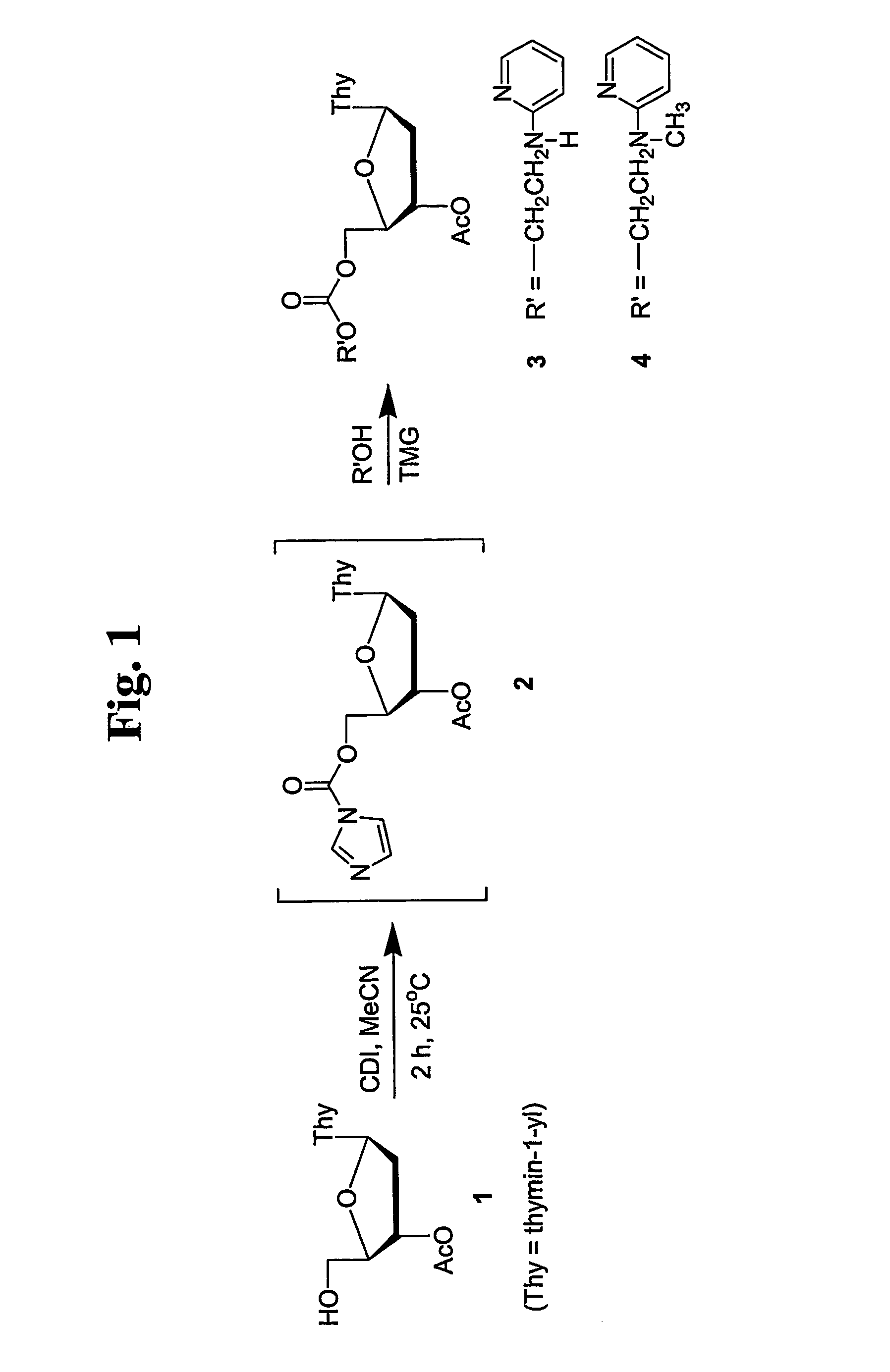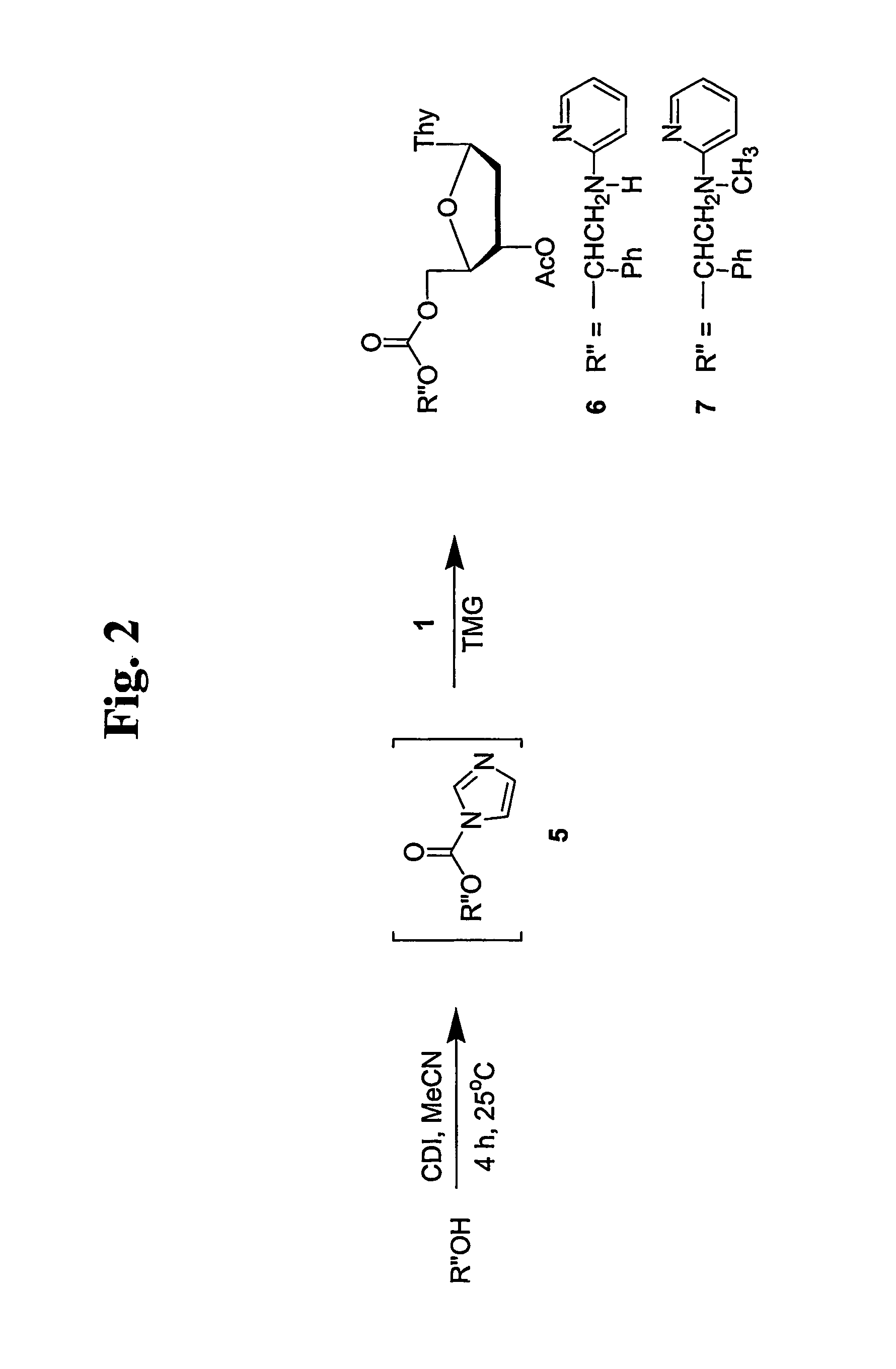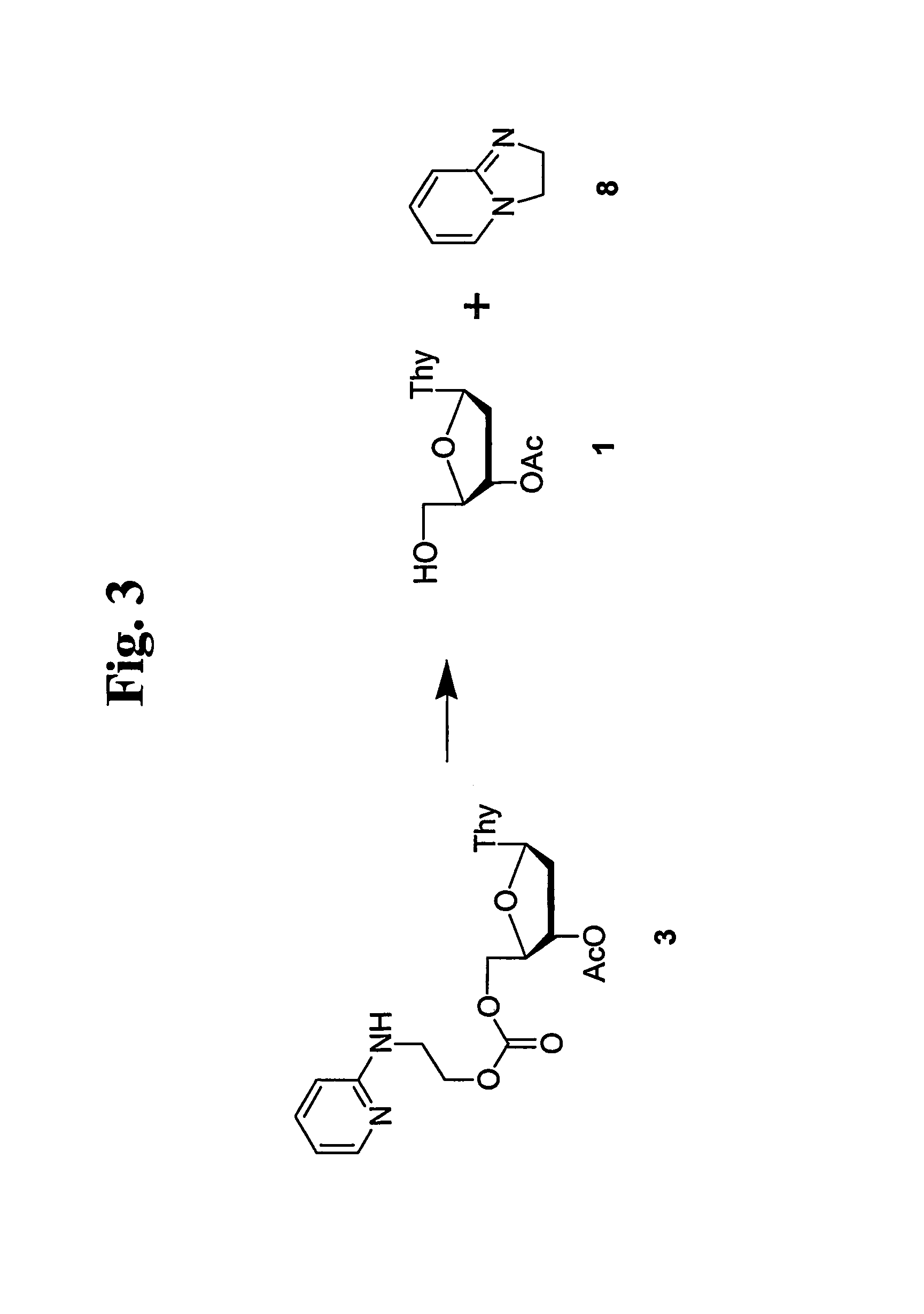Thermolabile hydroxyl protecting groups and methods of use
a technology of protecting groups and hydroxyls, applied in the field of thermally stable hydroxyl protecting groups, can solve the problems of limited range of structural oligonucleotide analogs that can be prepared using conventional hydroxyl protection technology
- Summary
- Abstract
- Description
- Claims
- Application Information
AI Technical Summary
Benefits of technology
Problems solved by technology
Method used
Image
Examples
example 1
[0157]This example demonstrates the preparation of 2-[N-Methyl-N-(2-pyridyl)]aminoethanol.
[0158]2-Bromopyridine (7.6 mL, 80 mmol) and 2-methylaminoethanol (12.8 mL, 160 mmol) were heated for 24 h in an oil bath kept at 160° C. The reaction mixture was then allowed to cool to ambient temperature and chloroform (300 mL) was added. The solution was shaken with a saturated solution of potassium carbonate (200 mL). The organic layer was dried over anhydrous magnesium sulfate and evaporated to dryness. The material left was distilled under reduced pressure affording a liquid (bp 112-115° C. @ 0.8 torr) (6.4 g, 46 mmol, 58%). 1H NMR (300 MHz, DMSO-d6): δ 8.04 (ddd, J=1.0, 2.0, 4.9 Hz, 1H), 7.46 (ddd J=2.0, 7.0, 8.7 Hz, 1H), 6.58 (ddd J=1.0, 2.0, 8.7 Hz, 1H), 6.51 (ddd J=2.0,4.9, 7.0 Hz, 1H), 3.56 (t, J=1.9 Hz, 4H), 3.01 (s, 3H). 13C NMR (75 MHz, DMSO-d6): δ 36.7, 51.7, 58.5, 105.5, 110.9, 137.0, 147.3, 158.2. FAB-HRMS: calcd for C8H13N2O M+H)+ 153.1028, found 153.1034.
example 2
[0159]This example demonstrates the preparation of (±)-1-Phenyl-2-(2-pyridyl)aminoethanol.
[0160](±)-1-Phenyl-2-(2-pyridyl)aminoethanol was prepared according to the procedure of Gray et al., J. Am. Chem. Soc., 81, 4351-4355 (1959) and was isolated as a solid in 60% yield. 1H NMR (300 MHz, DMSO-d6): δ 7.96 (ddd, J=1.0, 2.0, 5.0 Hz, 1H), 7.35 (m, 6H), 6.52 (ddd, J=1.0, 2.0, 8.5 Hz, 1H), 6.47 (ddd, J=2.0, 5.0, 7.0 Hz, 1H), 5.65 (d, J=4.2 Hz, 1H), 4.75 (m, 1H), 3.51 (ddd, J=4.3, 6.7, 13.4 Hz, 1H), 3.26 (ddd, J=5.1, 7.9, 13.4 Hz, 1H). 13C NMR (75 MHz, DMSO-d6): δ 49.2, 71.5, 108.4, 111.5, 125.9, 126.7, 127.9, 136.5, 144.2, 147.2, 158.8. FAB-HRMS: calcd for C13H15N2O (M+H)+ 215.1184, found 215.1192.
example 3
[0161]This example demonstrates the preparation of (±)-2-[N-Methyl-N-(2-pyridyl)amino]-1-phenylethanol.
[0162](±)-2-[N-Methyl-N-(2-pyridyl)]amino-1-phenylethanol was prepared in a manner identical to that of 1-phenyl-2-(pyridyl)aminoethanol, and was isolated as an oil in 55% yield. The crude oil was redistilled as recommended in the literature.27 1H NMR (300 MHz, DMSO-d6): δ 8.08 (ddd, J=1.0, 2.0, 5.0 Hz, 1H), 7.47 (ddd, J=2.0, 7.0, 8.8 Hz, 1H), 7.32 (m, 5H), 6.60 (m, 1H), 6.54 (ddd, J=2.0, 5.0, 7.0 Hz, 1H), 4.85 (dd, J=4.8, 7.8 Hz, 1H), 3.62 (ddd, J=4.8, 7.8, 14.1 Hz, 2H), 2.90 (s, 3H). 13C NMR (75 MHz, DMSO-d6): δ 37.5, 58.0, 70.8, 105.6, 111.0, 125.8, 126.8, 127.8, 136.9, 144.1, 147.3, 158.1. FAB-HRMS: calcd for C14H17N2O (M+H)+ 229.1341, found 229.1346.
PUM
| Property | Measurement | Unit |
|---|---|---|
| temperatures | aaaaa | aaaaa |
| temperature | aaaaa | aaaaa |
| temperature | aaaaa | aaaaa |
Abstract
Description
Claims
Application Information
 Login to View More
Login to View More - R&D
- Intellectual Property
- Life Sciences
- Materials
- Tech Scout
- Unparalleled Data Quality
- Higher Quality Content
- 60% Fewer Hallucinations
Browse by: Latest US Patents, China's latest patents, Technical Efficacy Thesaurus, Application Domain, Technology Topic, Popular Technical Reports.
© 2025 PatSnap. All rights reserved.Legal|Privacy policy|Modern Slavery Act Transparency Statement|Sitemap|About US| Contact US: help@patsnap.com



